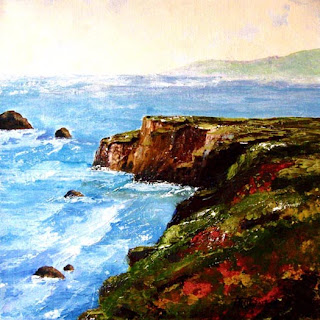"Double Bogey"
The "Double Bogey" painting was a great experience to paint, due to the love
of golf. This is one of my favorite sports,
truly a “Gentleman's Game”
The painting is of the 16th hole on Bandon Dunes in Oregon. Painting is Oil on canvas and is 20x40 with 1.5 inch on sides unframed. Painting is framed in a beautiful wood floating frame to complement the painting.
I grew up on a golf
course during my high school years. Other than golfing, I used to find the golf
balls in the ruff and would sell them in front of the pro-shop for 25 cents
each. A beautiful way to make extra money as a kid during the summer for my
collage fund.
Double Bogey was named by one of my art buyers of the
original” Hare & Hounds” oil painting. Kevin loves the game and spotted my
process of the painting in stages on my artist facebook page. He said, that looks like a “Double Bogey”, so
that stuck with the painting…. Thank you Kevin !!!!
Anyone who has ever played this course can relate to that
term “double bogey” or any tough course.
I have to admit, this was not an easy painting to paint, due
to a lot of green, and wanting to keep the depth in the painting. I did not
want the painting to look like a photograph, so keeping that feeling was very
important to me.
History of the Bandon Dunes Golf
Course
Decades ago, another
guy fell in love with the game of golf. That wouldn’t have made for much of a
story, except this wasn’t just any guy. Mike Keiser had achieved great success
in business and had the resources to pursue his passion. He traveled to the birthplace
of the game to absorb the traditions and heritage of the last 500 years of golf
and to play in the elements where the game was invented. He was so inspired
that he decided to build a golf course on Lake Michigan, a nine-hole course
that would eventually become the highest ranked in the U.S.
Over the years, he
played many of the world’s best courses, most of which were private clubs, and
became committed to the principle that every golfer should have the opportunity
to play great courses. It was then that he decided to build his own vision of
what golf should be.
He discovered the
ideal property in the sand dunes near Bandon, Oregon, and then made three
important decisions. First, he hired friend and confidant Howard McKee
to develop a land plan and work with City and County officials to move the
vision forward. Second, he retained KemperSports
to manage the construction phase and to assume overall management of the
project when completed. Third, he hired an untested young Scotsman, David McLay
Kidd, the son of the legendary head agronomist at Gleneagles in Scotland, to
design the first course. David spent 18 hours a day studying the land in order
to fulfill Mike’s vision of a true links experience. Bandon Dunes opened in
1999 to unprecedented reviews and remains one of the finest links courses in
the nation.
The first course
alone put Bandon Dunes on the map of favorite American golf destinations, but
Mike wasn’t finished. He retained the services of Tom Doak, noted minimalist
golf course architect and one of the world’s foremost authorities on links
golf, to work the dunes just north of Bandon Dunes to create Pacific Dunes. Opened
in 2001, the course has consistently ranked among the very best courses in the
U.S.
His vision not yet
complete, Mike then turned to renowned architects Bill Coore and Ben Crenshaw
to design the third course, Bandon Trails. Opened in 2005, the course offers a
journey through the same kind of land where the game of golf was born. Starting
on massive sand dunes, working through open meadows to an upland coastal
forest, then finishing again in the dunes, the course was the perfect
complement to Bandon and Pacific Dunes.
The fourth course opened in June 2010, and it came
from special inspiration. Of all the incredible tracks around the world Mike
has had the opportunity to play, his favorite remains National Golf Links on
Long Island. Designed by Charles Blair Macdonald, the course opened in 1911 and
ushered in the Golden Age of Golf Architecture in the U.S. One question burned
inside Mike Keiser: What would his favorite golf course architect have done
with the pristine land at Bandon Dunes? Mike asked Tom Doak and Jim Urbina to
return, this time to work the sand north of Pacific Dunes and design a course
in the tradition of C.B. Macdonald’s masterpiece at National Golf Links.
As Bandon Dunes continues to grow, so does Mike’s vision of offering golf as it
was meant to be.








